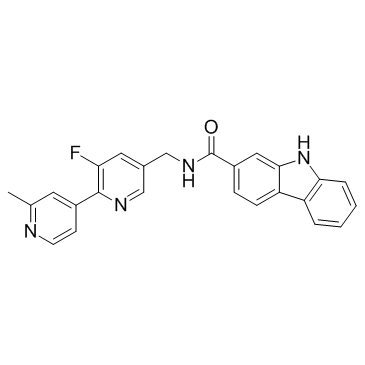| Cas No.: | 2036044-77-4 |
| SMILES: | FC1=C(C2=CC(C)=NC=C2)N=CC(CNC(C3=CC=C(C(C=CC=C4)=C4N5)C5=C3)=O)=C1 |
| Formula: | C25H19FN4O |
| M.Wt: | 410.44 |
| Purity: | >98% |
| Sotrage: | 2 years -20°C Powder, 2 weeks 4°C in DMSO, 6 months -80°C in DMSO |
| Description: | Porcupine-IN-1 is potent porcupine inhibitor with an IC50 of 0.5±0.2 nM. |
| Target: | IC50: 0.5±0.2 nM (Porcupine inhibitor)[1] |
| In Vivo: | Porcupine-IN-1 demonstrates moderate clearance under the treatment of human liver microsomes (57 mL/min/kg) and rat liver microsomes (24 mL/min/kg). It exhibits high clearance when treated with mouse microsomes (109 mL/min/kg)[1]. |
| In Vitro: | Porcupine is an enzyme that catalyses the addition of palmitoleate to a serine residue in Wnt proteins, a process which is required for the secretion of Wnt proteins. Porcupine-IN-1 is as potent as the clinical compound LGK974 in a cell based STF reporter gene assay. Porcupine-IN-1 potently inhibits the secretion of Wnt3A, therefore is confirmed to be a porcupine inhibitor[1]. |
| Cell Assay: | HEK293T cells are transfected with pLinbin-Wnt3A plasmid or vehicle control. The HEK293T cells are then treated with or without compounds (Porcupine-IN-1). Western Blot is used after 48 h to analyze both the cell lysis and culture medium[1]. |
| References: | [1]. Xu Z, et al. Design, synthesis, and evaluation of novel porcupine inhibitors featuring a fused 3-ring system based on the 'reversed' amide scaffold. |

 To enhance service speed and avoid tariff delays, we've opened a US warehouse. All US orders ship directly from our US facility.
To enhance service speed and avoid tariff delays, we've opened a US warehouse. All US orders ship directly from our US facility.




















